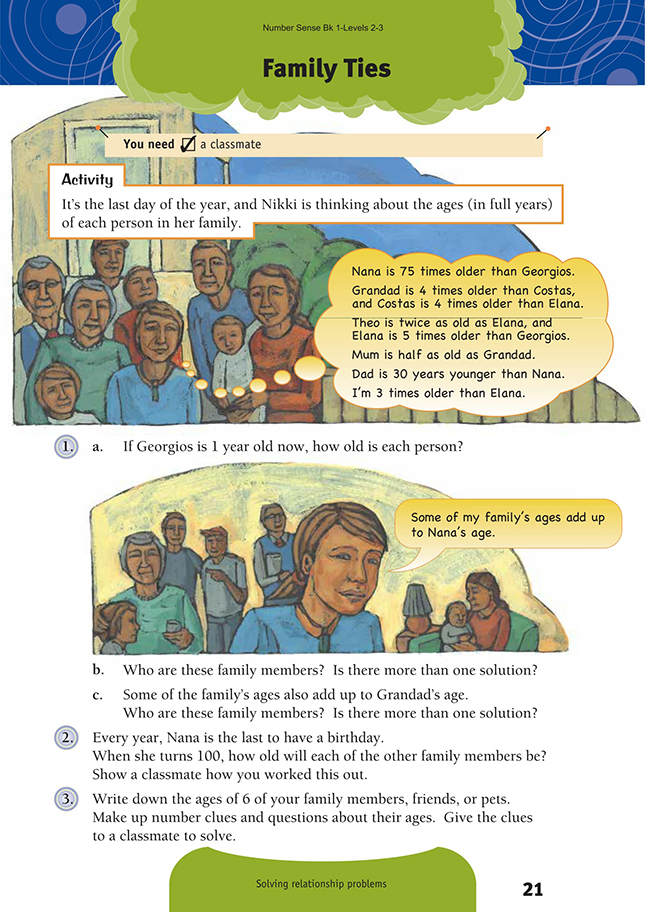This is a level 3 number activity from the Figure It Out series. It relates to Stage 6 of the Number Framework.
A PDF of the student activity is included.
Click on the image to enlarge it. Click again to close. Download PDF (252 KB)
use mental strategies involving addition and multiplication to solve problems
Number Framework Links
Use this activity to help the students who are using early additive strategies (stage 5) to become confident at this stage in the operational domains of addition and subtraction and multiplication and division. It is also suitable as an independent activity for students at the advanced additive stage (stage 6) or higher.
FIO, Levels 2-3, Number Sense and Algebraic Thinking, Book One, Family Ties, page 21
A classmate
This activity explores relationships involving addition and multiplication. The family context encourages students to take the ideas out of the classroom and use them to explore similar relationships in their own lives.
Whether in a guided teaching group or in an independent group, the students need to discover how to use the one age they know (Georgios’s) to work out the ages of the others. The key is to look for age statements that include Georgios’s age. There are two of these. The students then work progressively from the known to the unknown.
Have the students move into small groups to find the ages. You could get them to number the statements in the bubble as 1–8 and to record the order in which they use the statements and the information they deduce from each.
Use question 2 as an opportunity for the students to see the pattern of adding 25 and use it as a generalisation for this question. Don’t tell the students the “add 25” relationship. Let them solve a number of the ages for themselves. Encourage them to find the generalisation: Is there a connection between the answers in question 1a and the ones you are now getting?
In question 3, have the students record their number clues in words and as equations.
Answers to Activity
1. a. Georgios is 1, Elana is 5, Theo is 10, Nikki is 15, Costas is 20, Mum is 40,
Dad is 45, Nana is 75, and Grandad is 80.
b. There are 4 possible solutions:
Mum, Costas, Nikki (40 + 20 + 15 = 75);
Dad, Nikki, Theo, Elana (45 + 15 + 10 + 5 = 75);
Mum, Costas, Theo, Elana (40 + 20 + 10 + 5 = 75);
Dad, Costas, Theo (45 + 20 + 10 = 75)
c. There are 4 possible solutions:
Mum, Costas, Nikki, Elana (40 + 20 + 15 + 5 = 80);
Dad, Costas, Nikki (45 + 20 + 15 = 80);
Nana, Elana (75 + 5 = 80);
Dad, Costas, Theo, Elana, (45 + 20 + 10 + 5 = 80)
2. Georgios: 26 (1 + 25)
Elana: 30 (5 + 25)
Theo: 35 (10 + 25)
Nikki: 40 (15 + 25)
Costas: 45 (20 + 25)
Mum: 65 (40 + 25)
Dad: 70 (45 + 25)
Grandad: 105 (80 + 25)
The simplest strategy is to add 25 to each family member’s current age.
3. Problems will vary.
